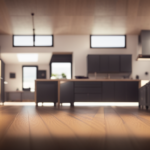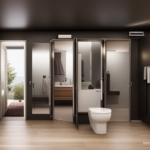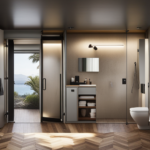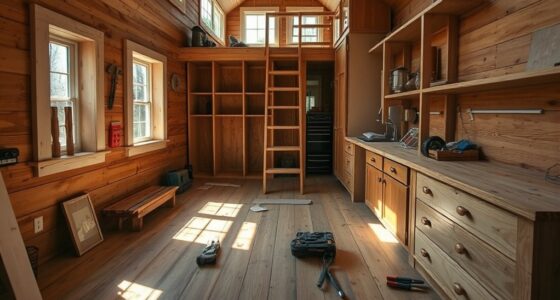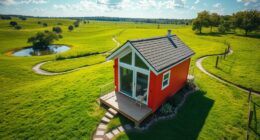Are you fed up with feeling confined in your small house? We have the perfect solution for you!
Get ready to have your mind blown as we explore how innovative layout techniques can revolutionize tiny house design.
From maximizing space with multi-function furniture to smart storage solutions, we’ll show you how to transform your tiny house into a spacious and functional haven.
Say goodbye to clutter and hello to a whole new level of tiny house living.

Let’s dive in and discover the possibilities together!
Key Takeaways
- Innovative layout techniques can maximize functionality in every square inch of a tiny house.
- Incorporating space-saving furniture and compact design ideas can revolutionize tiny house design.
- Thinking creatively to find transformative solutions for small spaces is essential in tiny house design.
- Utilizing every square inch effectively and optimizing space can enhance the efficiency and comfort of tiny house living.
Space Optimization in Tiny House Design
We can achieve maximum space optimization in tiny house design by utilizing innovative storage solutions. By incorporating space saving hacks and compact design concepts, we can create functional and efficient living spaces that serve the needs of individuals desiring a minimalist lifestyle.
One effective strategy is to utilize multi-purpose furniture, such as a sofa that can be transformed into a bed or a dining table that can be folded against the wall when not in use. Additionally, utilizing vertical space through the use of wall-mounted shelves and overhead storage can greatly increase the available storage area. Incorporating built-in storage solutions, such as hidden compartments in stairs or under the floor, can also maximize space.
Impact of Minimalist Interior on Aesthetics
Our choice to embrace a minimalist interior has a significant impact on the overall aesthetics of a tiny house design. By opting for minimalist decor, we create a clean, clutter-free space that exudes a sense of tranquility and simplicity. This intentional design choice not only enhances the visual appeal of the tiny house but also has a profound psychological impact on its inhabitants.
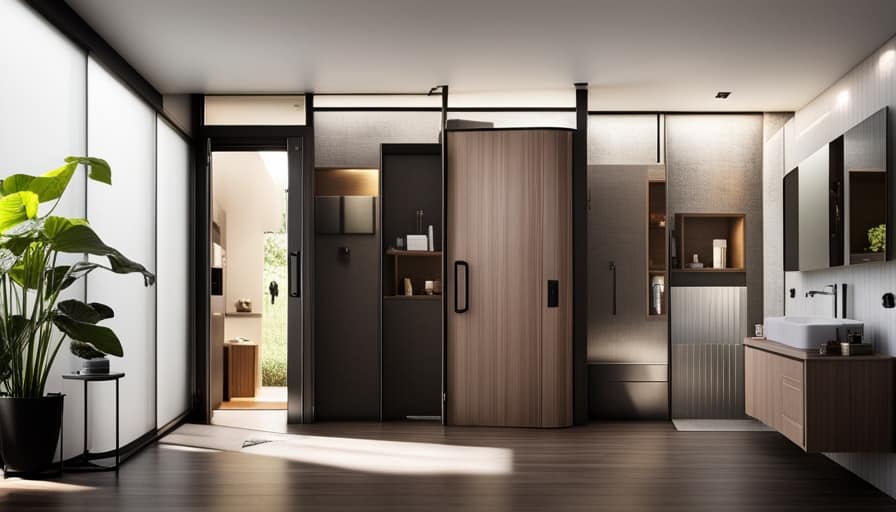
A minimalist interior promotes a sense of calm and reduces stress by eliminating unnecessary visual distractions. It allows for better focus and concentration, making the space more functional and efficient. Additionally, the use of minimalistic design elements such as neutral color palettes, natural textures, and simple lines creates a timeless and elegant atmosphere.
To better understand the impact of minimalist interior on aesthetics, let’s take a look at the following table:
| Benefits of Minimalist Interior | Aesthetic Impact |
|---|---|
| Clutter-free and organized space | Clean and sleek appearance |
| Reduced visual distractions | Enhanced visual appeal |
| Increased functionality and efficiency | Timeless and elegant atmosphere |
Maximizing Space With Multi-Function Furniture
By utilizing multi-function furniture, we can effectively maximize the limited space in a tiny house design. Maximizing efficiency is crucial when it comes to small living spaces, and incorporating multi-function furniture is a smart solution. These pieces of furniture are designed to serve multiple purposes, allowing for versatility and functionality in a compact area.
One popular example of multi-function furniture is a sofa that can be transformed into a bed. This modular design allows for easy conversion between seating and sleeping arrangements, making the most out of the available space. Additionally, there are tables that can be extended or folded down, providing a larger surface area when needed and saving space when not in use.

Another great feature of multi-function furniture is storage integration. Many pieces are designed with hidden compartments or built-in shelving, providing additional storage options without sacrificing floor space. This helps to keep a tiny house organized and clutter-free.
Smart Storage Solutions for Tiny Houses
When it comes to designing storage solutions for tiny houses, we must consider hidden storage options, multi-functional furniture ideas, and creative space-saving solutions.
Hidden storage options, such as built-in cabinets and drawers under stairs or beds, can help maximize every inch of space.
Multi-functional furniture ideas, like foldable tables or beds with built-in storage, provide dual purposes without sacrificing functionality.

Lastly, creative space-saving solutions, such as wall-mounted shelves or hanging organizers, can help utilize vertical spaces effectively.
Hidden Storage Options
Transforming small spaces with clever storage solutions is a key aspect of revolutionizing tiny house design. In order to maximize the functionality of limited space, hidden storage options are essential. These innovative ideas not only provide ample storage but also help in creating a clutter-free living environment.
Here are some space-saving techniques and hidden storage ideas that can be incorporated into tiny house design:
| Hidden Storage Ideas | Space Saving Techniques |
|---|---|
| Built-in wall cabinets | Loft beds |
| Under-stair storage | Foldable furniture |
| Murphy beds | Wall-mounted shelves |
| Bench seating with storage | Sliding doors |
Multi-Functional Furniture Ideas
We can maximize the functionality of tiny houses by incorporating multi-functional furniture ideas that offer smart storage solutions. Here are four innovative multi-functional furniture ideas that are perfect for compact living:

-
Convertible Sofa: A sofa that can transform into a bed is a great space-saving solution. It provides a comfortable seating area during the day and easily converts into a cozy bed at night.
-
Foldable Dining Table: A dining table that can be folded and stored when not in use is a practical choice for small spaces. It allows you to have a dining area when needed and frees up space when you don’t.
-
Wall-Mounted Desk: A wall-mounted desk is a fantastic option for a home office in a tiny house. It can be folded up against the wall when not in use, saving valuable floor space.
-
Ottoman with Storage: An ottoman that doubles as a storage unit is a clever way to maximize space. It provides extra seating while also offering a hidden storage compartment for items like blankets, books, or toys.
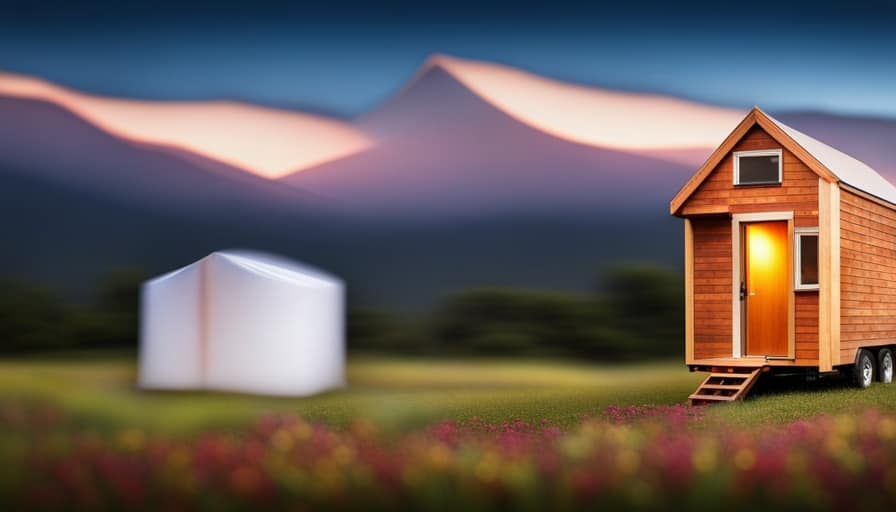
By incorporating these multi-functional furniture ideas, we can create smart storage solutions that optimize the limited space in tiny houses.
In the next section, we’ll explore creative space-saving solutions to further enhance the functionality of these compact homes.
Creative Space-Saving Solutions
Let’s explore some ingenious ways to maximize storage in tiny houses through creative space-saving solutions. When designing a tiny house, it’s crucial to utilize every inch of available space efficiently. One way to achieve this is by incorporating space-saving furniture and compact living concepts. These innovative solutions allow for multi-purpose functionality while saving valuable floor space.
Here are some examples of space-saving furniture and compact living concepts that can revolutionize tiny house design:

| Furniture/Concept | Description | Benefits |
|---|---|---|
| Loft Beds | Elevated beds that provide storage or living space underneath. | Maximizes vertical space, creates additional storage or living areas. |
| Wall-Mounted Tables | Tables that can be folded against the wall when not in use. | Saves floor space, provides a functional dining or workspace. |
| Built-in Storage | Customized storage solutions built into walls, stairs, or furniture. | Utilizes every available space, reduces clutter. |
| Sliding Walls | Walls that can be moved or folded to create flexible room configurations. | Adaptable layout, maximizes space utilization. |
| Hidden Storage | Concealed compartments or furniture with hidden storage compartments. | Keeps belongings organized, reduces visual clutter. |
Roof Selection and Functionality in Tiny House Design
Our team believes that the roof plays a crucial role in the overall functionality and design of a tiny house. Here are four key considerations for roof selection and functionality in tiny house design:
-
Roof Design: The choice of roof design can greatly impact the interior space and aesthetic appeal of a tiny house. A shed roof allows for higher ceilings and more vertical space, while a gable roof provides a traditional and visually pleasing look.
-
Ventilation Solutions: Proper ventilation is essential in a tiny house to maintain air quality and prevent moisture buildup. Incorporating features like skylights, roof vents, or ridge vents can help promote airflow and keep the interior comfortable.
-
Insulation: A well-insulated roof is vital for energy efficiency and climate control in a tiny house. Consider using materials with high R-values and ensuring proper installation to minimize heat transfer and maximize comfort.
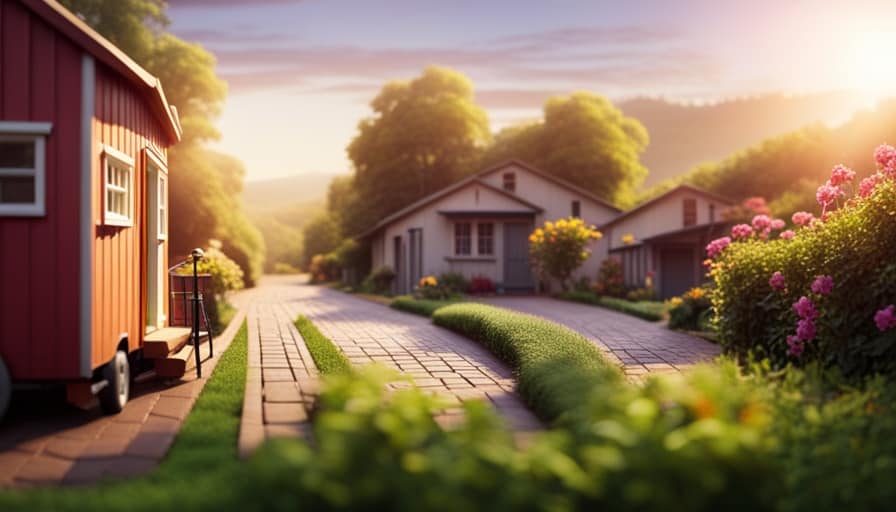
-
Roof Materials: Choose durable and lightweight roof materials that can withstand the elements without adding unnecessary weight to the structure. Options like metal roofing or composite shingles offer longevity and require minimal maintenance.
Redefining Tiny House Design Through Innovative Layout Techniques
One of the key ways to redefine tiny house design is through incorporating innovative layout techniques. By maximizing natural light and incorporating outdoor spaces, tiny houses can feel more spacious and connected to the surrounding environment.
| Innovative Layout Techniques | Benefits |
|---|---|
| Large windows and skylights | Maximizes natural light, creates a sense of openness |
| Multi-functional furniture | Maximizes space utilization, allows for flexibility in room arrangement |
| Loft spaces | Utilizes vertical space, creates separate areas for sleeping and living |
| Outdoor living areas | Expands usable space, enhances connection to nature |
Incorporating these innovative layout techniques into tiny house design not only improves functionality but also enhances the overall living experience. By bringing in more natural light, occupants can enjoy the benefits of improved mood and increased productivity. Additionally, incorporating outdoor spaces allows for a seamless transition between indoor and outdoor living, creating a sense of freedom and connection to nature.
These innovative layout techniques lay the groundwork for the subsequent discussion on the significance of energy-efficient design in tiny houses.

Significance of Energy-Efficient Design in Tiny Houses
We can’t underestimate the importance of energy-efficient design in tiny houses, as it can significantly reduce the environmental impact and contribute to long-term cost savings.
Here are four reasons why energy-efficient design is significant in tiny houses:
-
Energy efficient insulation: Proper insulation helps to minimize heat loss and gain, reducing the need for heating and cooling systems. This leads to lower energy consumption and reduced utility bills.
-
Sustainable materials: Using sustainable materials in the construction of tiny houses not only reduces the environmental impact but also promotes healthier indoor air quality. Materials like reclaimed wood, recycled insulation, and low VOC paints contribute to a more eco-friendly and sustainable living environment.

-
Reduced carbon footprint: Energy-efficient design in tiny houses helps to reduce the overall carbon footprint by minimizing energy consumption. This is crucial in combating climate change and preserving our planet for future generations.
-
Financial savings: By incorporating energy-efficient design elements, tiny house owners can save money on energy bills in the long run. The initial investment in energy-efficient features pays off over time through reduced energy consumption and lower operating costs.
Revolutionizing Tiny House Design With Innovative Layout Techniques
When it comes to revolutionizing tiny house design, there are several innovative layout techniques that can make a significant impact.
One such technique is space optimization strategies, which involve maximizing every inch of available space to create a functional and comfortable living environment.

Another technique is the use of multi-functional furniture ideas, where each piece serves multiple purposes to save space and enhance functionality.
Lastly, creative storage solutions play a crucial role in tiny house design, allowing for efficient organization and storage of belongings.
Space Optimization Strategies
Our innovative layout techniques can revolutionize tiny house design by implementing space optimization strategies. By utilizing space saving furniture and incorporating compact design ideas, we can maximize the functionality of every square inch in a tiny house.
Here are four space optimization strategies that can greatly enhance the design of a tiny house:

-
Multi-purpose furniture: Investing in furniture pieces that serve multiple functions, such as a sofa that can also be used as a bed or a coffee table that doubles as a dining table, can greatly save space and increase versatility.
-
Built-in storage solutions: Utilizing built-in storage options like hidden cabinets, wall-mounted shelves, and under-bed storage compartments can help keep the living space organized and clutter-free.
-
Utilizing vertical space: Taking advantage of vertical space by incorporating tall bookshelves, hanging storage systems, and lofted sleeping areas can effectively maximize the available square footage.
-
Open floor plan: Creating an open floor plan layout can’t only make the tiny house feel more spacious but also allow for flexible use of the living space.

With these space optimization strategies, we can create tiny house designs that aren’t only efficient but also comfortable and functional.
Now, let’s explore the next section on multi-functional furniture ideas.
Multi-Functional Furniture Ideas
By incorporating multi-functional furniture ideas, we can revolutionize tiny house design by maximizing space and versatility. One innovative idea is modular seating, which allows for flexible configurations to accommodate different needs. These seating modules can be rearranged to create a sofa, a bed, or even a dining area, providing comfort and functionality in a small space.
Another great concept is the use of convertible tables. These tables can be expanded or collapsed to adjust to different activities and save space when not in use. They can serve as a dining table, a desk, or even a storage unit.

The key to successful tiny house design is to think creatively and find furniture solutions that can serve multiple purposes. With modular seating and convertible tables, we can create a truly transformative and efficient living space in a tiny house.
Creative Storage Solutions
We can achieve a revolution in tiny house design by implementing creative storage solutions that maximize space and functionality. Innovative organization and efficient space utilization are key factors in creating storage solutions that work effectively in tiny houses.
Here are four creative storage solutions that can revolutionize tiny house design:
-
Built-in shelving: Utilize vertical space by incorporating built-in shelves into walls or under staircases. This allows for efficient storage of books, decor, and other items while minimizing floor space usage.

-
Multipurpose furniture: Opt for furniture pieces that serve multiple functions, such as a sofa that can be transformed into a bed or a coffee table with built-in storage compartments. This helps maximize space while providing essential storage options.
-
Hidden storage: Incorporate hidden storage compartments into furniture pieces or walls, such as pull-out drawers under beds or cabinets built into stair risers. This allows for discreet storage while maintaining a clutter-free appearance.
-
Ceiling storage: Install overhead storage solutions, such as hanging racks or ceiling-mounted shelves, to utilize vertical space that’s often overlooked. This provides additional storage options without taking up valuable floor space.
Frequently Asked Questions
What Are Some Examples of Multi-Function Furniture That Can Maximize Space in a Tiny House?
In our search for space-saving solutions, we’ve found some amazing examples of multi-functional furniture. These pieces are designed to maximize space in tiny houses, offering versatility and efficiency without sacrificing style or comfort.
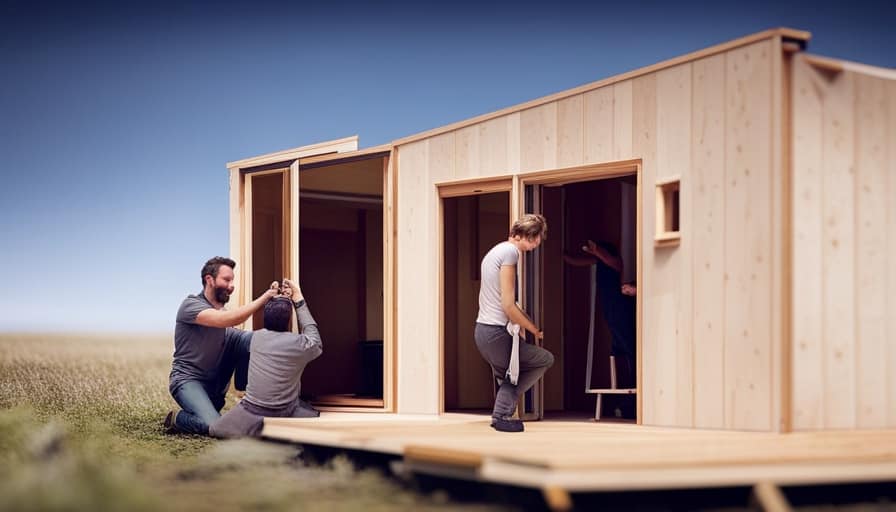
How Can Energy-Efficient Design Be Incorporated Into the Layout of a Tiny House?
Incorporating renewable energy sources and creating a seamless indoor outdoor living space are key aspects of energy-efficient design in a tiny house. We can revolutionize tiny house layout by prioritizing these elements.
What Are Some Innovative Layout Techniques That Can Revolutionize Tiny House Design?
Innovative space saving techniques and creative room partitioning can revolutionize tiny house design. These techniques maximize the use of limited space, allowing for a more efficient and functional living experience.
How Does the Selection of the Roof Impact the Functionality of a Tiny House?
When it comes to the impact of roof selection on a tiny house, we’ve seen how it can make or break functionality. For example, a well-designed roof can provide space-saving opportunities for innovative furniture arrangements.
Can You Provide Examples of Smart Storage Solutions Specifically Designed for Tiny Houses?
We can provide examples of smart storage solutions and space-saving furniture specifically designed for tiny houses. These innovative techniques maximize storage space and help optimize the functionality of small living spaces.

Conclusion
In conclusion, innovative layout techniques have the potential to revolutionize tiny house design by maximizing space and functionality.
According to a recent study, implementing smart storage solutions in tiny houses can increase usable space by up to 30%.
This statistic highlights the significant impact of efficient storage solutions in creating a more livable and comfortable environment.
By embracing innovative layout techniques, tiny house owners can truly optimize their living spaces and redefine the possibilities of minimalist living.

I’m Theodore, and I love tiny houses. In fact, I’m the author of Tiny House 43, a book about tiny houses that are also tree houses. I think they’re magical places where imaginations can run wild and adventures are just waiting to happen.
While tree houses are often associated with childhood, they can be the perfect adult retreat. They offer a cozy space to relax and unwind, surrounded by nature. And since they’re typically built on stilts or raised platforms, they offer stunning views that traditional homes simply can’t match.
If you’re looking for a unique and romantic getaway, a tree house tiny house might just be the perfect option.



